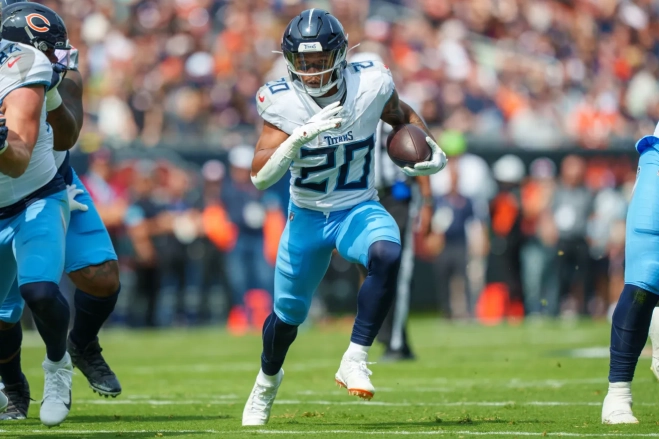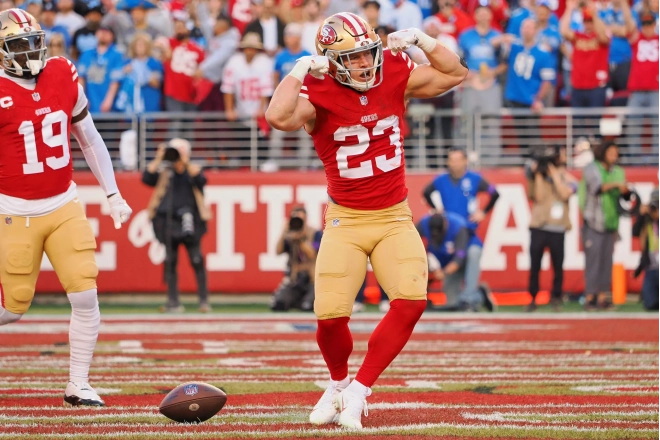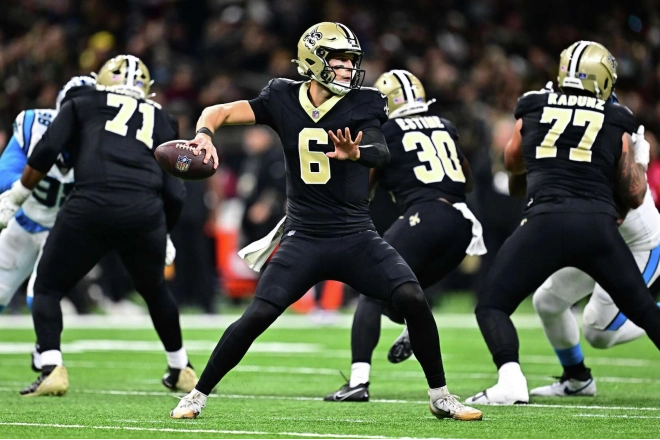The NFL running back market is actually pretty unhealthy with multiple stars (Austin Ekeler, Saquom Barkley) sitting out this off-season in search of fair compensation. The position isn't valued at the professional level, but many college teams (especially the lower level) build their teams around their running backs. Despite the questionable future of the position financially, the position is saturated with talent. Let's take a look at some of the different college running back types seen last NCAA season.
This Part 1 article focusses on dual-threat running backs.
Modern NFL offenses require more than a bell cow ball carrier, in certain situations they need the running back to morph into a receiver for pass plays. Over the course of the 2022 NCAA season these running backs stressed defenses in and out the backfield:
Evan Hall (Northwestern)
Rushing Yards Per Game: 76
Receiving Yards Per Game: 46
Height: 5'10-1/8", Weight: 209 lbs
Positives: Evan Hall has great short-area ability as a rusher due to his elusive and slippery style as a runner while also providing secure hands in the passing game. Runs with patience and good vision. Handful for defenses to stop.
If not hurting them with the rush, he'll get involved in the passing game and vice versa.
Negatives: Evan Hull lacks intimidating size, needs a coach to set up space for him as he won’t truck people on the regular. Hull lacks that explosive burst at the second level (past the linebacker corps) as a runner. Slippery to get a hold of but doesn't exactly power through defenders. Finally, he is not from an elite conference.
Game to watch: Nebraska
Worst show: Iowa
Comp: Cam Akers
Jahmyr Gibbs (Alabama)
Rushing Yards Per Game; 77
Receiving Yards Per Game; 37
Height: 5'9", Weight: 199 lbs
Positives: Jahmyr Gibbs is a big play threat. He is an explosive rusher due to his break away speed and shifty style, while also being a playmaker threat in the passing game. His speed after the second level is impressive as he ghosts past defenders. Gibbs was a reliable pass catcher out the backfield for Bryce Young all season and he played in an elite conference.
Negatives: Gibbs lacks traditional size and weight of a bell cow back. He played on a well-coached and talented team, but might be a different player without the structure. He is not physically built to be a consistent contact runner, but a great offensive coach feeding him space would create a lethal playmaker. Finally he is undersized as a last line blocker for the QB.
Game to watch: Arkansas
Worst show: Miss ST
Comp: Kenneth Walker III
Zach Charbonnet (UCLA)
Rushing Yards Per Game: 136
Receiving Yards Per Game: 32
Height: 6'0", Weight: 214 lbs
Positives: Zach Charbonnet was one of the most productive running backs of the 2022 NCAA season on a per game basis, showing all the signs of a potential bell cow type back. Charbonnet has the traditional size and weight of a bell cow ball carrier. He knows how to play to his size to power through defenders but also displays light feet with how he dodges oncoming defenders. His initial burst when receiving the ball behind the line of scrimmage is as good as his break away pace past the second level.
Charbonnet is a traditional North-South running threat and his size and frame makes him a red zone threat. He possesses balance and arm tackle-breaking ability as a bigger back and consistently produced across games. A respectable offensive mind(Chip Kelly) built his offense around him.
Negatives: Played on a well coached and talented team, and could be a different player without the structure. Not a speed threat to break away from defenders after the second level. Dealt with injuries in college. Agility tests at the combine were below average.
Charbonnet fell out of rotation at his first school (Michigan) and had to transfer. Some fellow scouts note him as a bruiser/trucker type back because of his size, I only see that part of his game when he assuredly can't side step past the defender. In my opinion he isn't a contact first runner; it's a tool he has but rarely uses.
Game to watch: Stanford
Worst show: USC
Comp: Charles Sims
Michael Wiley (Arizona)
Rushing Yards Per Game; 70
Receiving Yards Per Game; 32
Height/Weight: 6'0", 210 pounds
Positives: Sadly for NFL front offices Michael Wiley is a 2024 draft prospect. Wiley is a rare mix of notable size, north-south break away pace and shifty side-to-side speed. A player of this size shouldn't be so smooth as a runner, moving at a frightening pace for his size.
Over the last two seasons Wiley has led the Arizona Wildcats offense in touchdowns. He has the makings of a bell cow ball carrier. Despite his huge frame, he displays light feet with how he dodges defenders, and if that doesn't work he knows how to play to his size and get yards after contact. His size and frame make him a red zone threat.
Negatives: Despite all the physical tools Wiley has inconsistent production. Wiley has fumbled in key situations before and would need to fix before he could be a key down player in the NFL. He also dealt with multiple injuries in college.
Game to watch: Arizona State University
Worst show: Oregon
Comp: Jamaal Williams
Kenny McIntosh (Georgia)
Rushing Yards Per Game; 55
Receiving Yards Per Game; 34
Height: 6'0", Weight: 204 lbs
Positives: McIntosh was used as a key weapon in both the rushing and passing game for last season's overall champions. McIntosh has great size but carries little weight on his frame to further showcase his elusive - shifty running style. He is a patient runner behind the offensive line. For a running back he is good at running receiving routes and was a respected leader on a national championship team. He could have transferred, but fought off competition for years to have a starting opportunity. McIntosh is a playmaker when the ball is in his hands.
Negative: McIntosh is quick but lacks break away pace and lacks that extra burst when he gets past the second level. His ability to consistently shake off tackles and produce yards after contact is in question. The light weight he needs to dodge defenders works against him when asked to pass block for the QB. He seems trapped between the receiving and running back roles while truly being neither. His receiving production was inconsistent. McIntosh was part of a running back committee, as his bell cow ability is in question and he might need a power back to compliment him in the NFL.
Game to watch: Kent State
Worst show: South Carolina
Comp: A bigger, slender D’Andre Swift
Deuce Vaughn (Kansas State University)
Rushing Yards Per Game: 111
Receiving Yards Per Game: 27
Height: 5'5", Weight: 179 lbs
Positives: Vaughn was one of college football's most explosive playmakers last season. He is an elite speed threat when receiving the ball followed by excellent break away pace to get past defenders coming at angles. He runs with easy acceleration. Vaughn is a great mix of speed and elusiveness; he can side step a defender and immediately hit the space in a hurry.
Vaughn has also had consistent production as a receiver over his three year career. He has reliable hands and has showcase route running ability. Vaugh is a playmaker in the open field.
Negative: The lack of size makes him a questionable pass blocker for the QB. Vaughn is not a bell cow back as he isn't built to be a consistent contact rusher. His yards after contact potential is low for players of his size. Vaughn needs to be paired with a bigger back, e.g. D.J. Giddens on his own team, that can fight between the tackles where Vaughn can't.
Game to watch: Kansas
Worst show: Iowa State
Comp: Darren Sproles
Nakia Watson (Washington State)
Rushing Yards Per Game: 70
Receiving Yards Per Game: 27
Height: 5'11", Weight: 179 lbs
Positives: Watson is a big back that carries his size well. He is often seen churning through contact between the tackles to make plays. The Washington State staff made use of him as a bell cow back. Watson is a traditional north-south runner with great straight-line speed.
Watson is not too shifty or elusive, but prefers to run over opponents. Watson shakes off tackles and picks up vital yards after contact on a regular basis. Watson has the size necessary to be an effective pass blocker for the QB. His initial burst at the line of scrimmage makes him an impactful short-yardage back with red zone threat potential.
Negative: Watson lacks a break away pace to get away from defenders in the second level and is also not one to side step past defenders. All that contact is an injury risk. In the passing game, Watson flashed some receiving talent, but Washington State rarely ever used him there. Finally, Watson is not from once of the more elite conferences.
Game to watch: Stanford/Oregon
Worst show: Fresno State
Comp: Chris Carson
Jayden Ott (California)
Rushing Yards Per Game: 75
Receiving Yards Per Game: 25
Height: 6'0", Weight: 200 lbs
Positives: As a freshman, Ott put up big numbers early. He doesn't have game changing speed but is still fast enough to break off long runs. Ott is an elusive and patient runner behind his offensive line despite his young age.
Ott is the ideal size with an eye-catching play style. He is big enough to perform blitz pickups with very good potential. Ott uses his agile body to be elusive and take away angles from defenders. Despite his inexperience, Ott showcased excellent vision and reliable hands in the passing game, demonstrating the traits of more senior backs.
Negatives: Ott's speed past the second level is just decent and his bell cow potential is questionable as he looks to avoid contact rather than ran straight into it. Ott would thrive in a running back committee as the change of pace running back option. He did not demonstrate great play did not take place in what many consider an elite conference with multiple next level defenders.
Game to watch: Arizona
Worst show: Notre Dame
Comp: Austin Ekeler
*** Information largely thanks to sports reference college football and @MathBomb(Twitter) Relative Athletic Score model.





